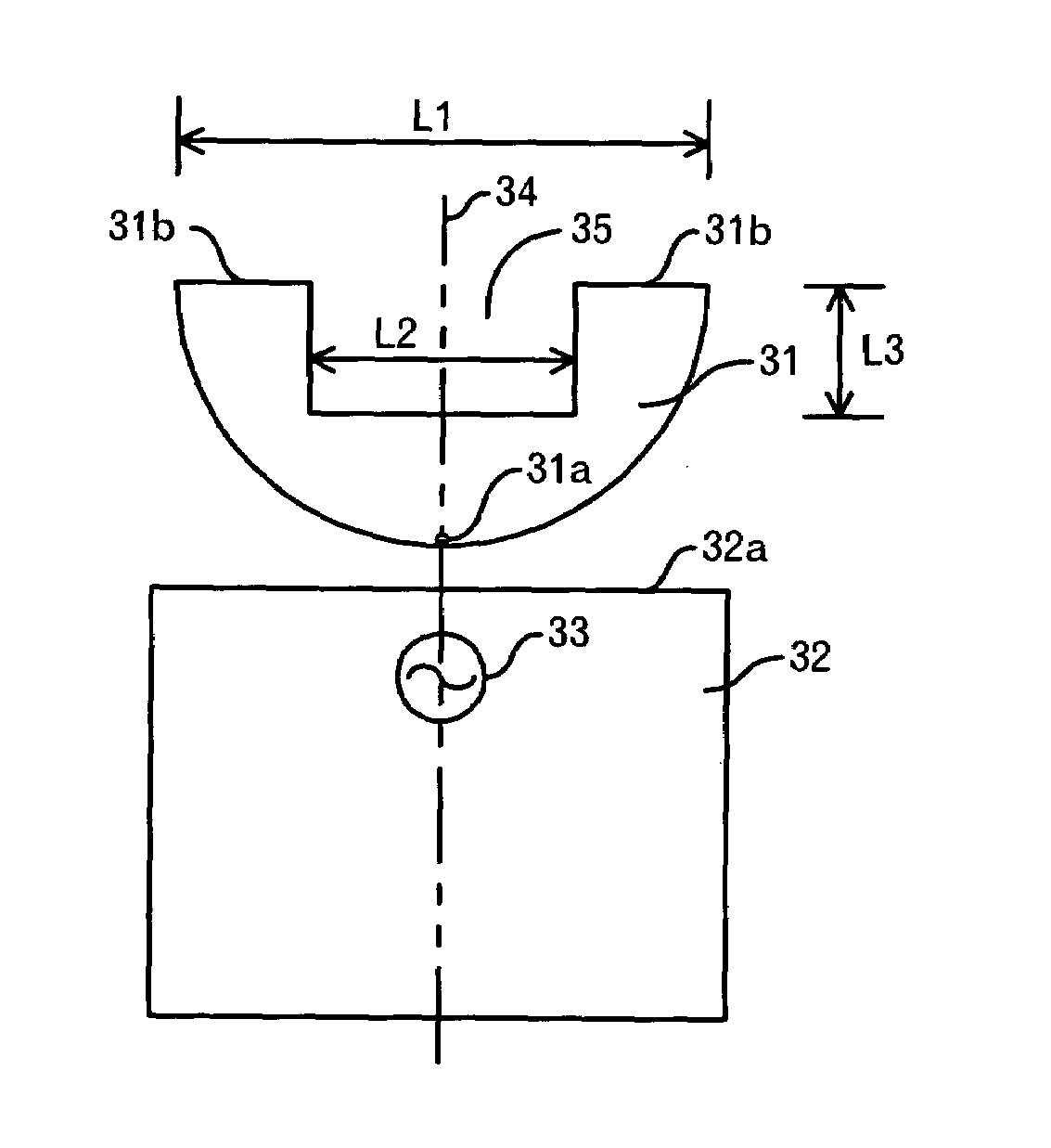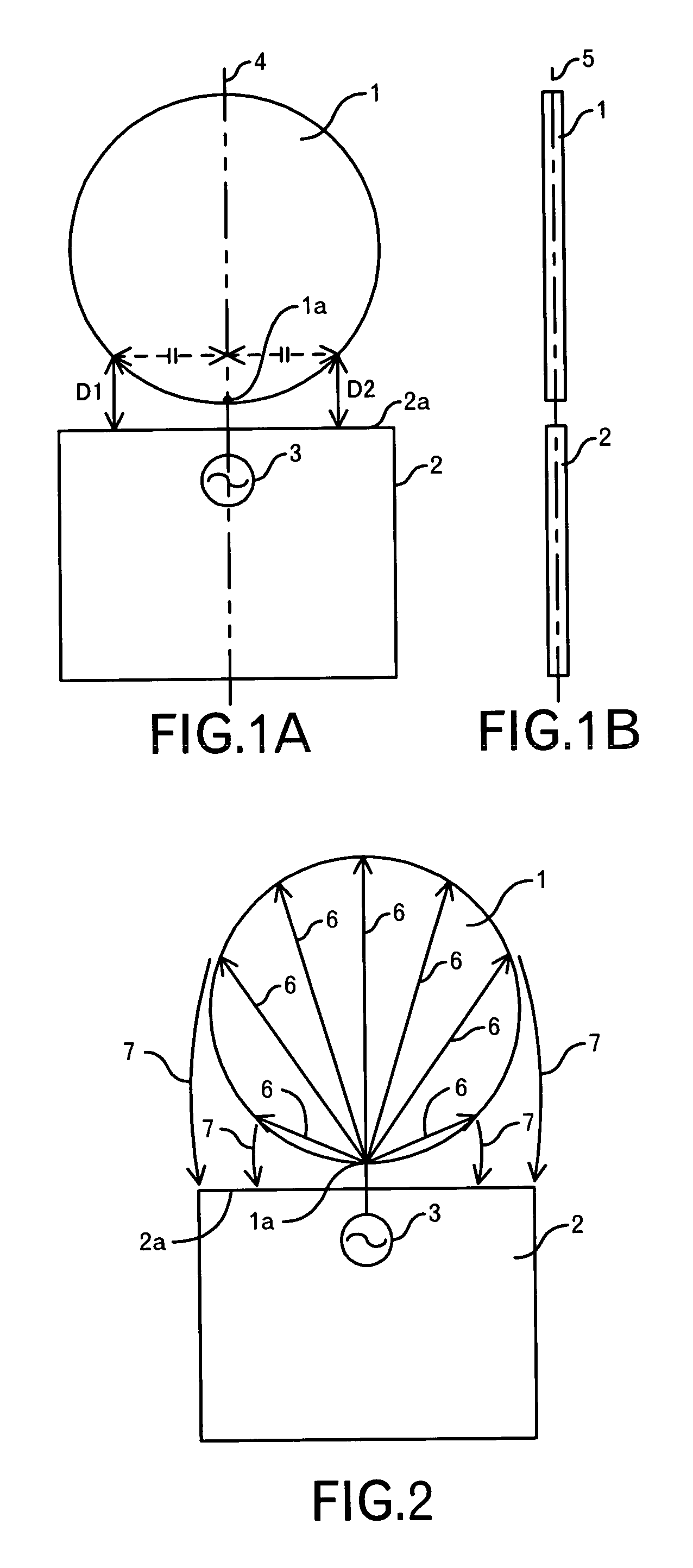Wide bandwidth antenna
a wide-band antenna and antenna technology, applied in the direction of resonant antennas, antenna earthings, elongated active element feeds, etc., can solve the problems of difficult to control the antenna characteristic, bad vswr characteristic, etc., and achieve the effect of widening the bandwidth
- Summary
- Abstract
- Description
- Claims
- Application Information
AI Technical Summary
Benefits of technology
Problems solved by technology
Method used
Image
Examples
first embodiment
1. First Embodiment
[0049]The structure of an antenna according to a first embodiment of the present invention is shown in FIG. 1A and FIG. 1B. As shown in FIG. 1A, the antenna according to the first embodiment is composed of a planar element 1, which is a circular flat conductor, a ground pattern 2 juxtaposed with the planar element 1, and a high frequency power source 3. The planar element 1 is connected with the high frequency power source 3 at a feed point 1a. The feed point 1a is located at such a position that the distance between the planar element 1 and the ground pattern 2 is shortest.
[0050]Moreover, the planar element 1 and the ground pattern 2 are designed symmetrically with respect to a line 4 passing through the feed point 1a. Accordingly, the shortest distance from any point on the arc of the planar element 1 to the ground pattern 2 is also designed to be symmetrical with respect to the line 4. That is, if the distance from the line 4 to each of two points on the arc of...
second embodiment
2. Second Embodiment
[0057]The structure of an antenna according to a second embodiment of the present invention is shown in FIG. 4. Similarly to the first embodiment, this antenna is composed of a planar element 11, which is a circular conductive plate, a ground pattern 12 juxtaposed with the planar element 11, and a high frequency power source 13 connected to a feed point 11a of the planar element 11. The feed point 11a is located at such a position that the distance between the planar element 11 and the ground pattern 12 is shortest.
[0058]Besides, the planar element 11 and the ground pattern 12 are symmetrical with respect to a straight line 14 passing through the feed point 11a. Furthermore, the length (hereinafter referred to as “distance”) of a line segment extending from any point on the arc of the planar element 11 to the ground pattern 12 in parallel with the line 14 is also symmetric with respect to the line 14. That is, if the distances from the straight line 14 are the sa...
third embodiment
3. Third Embodiment
[0063]The structure of an antenna according to a fifth embodiment of the present invention is shown in FIG. 5. The antenna according to this embodiment is composed of a planar element 21, which is a semicircular conductive flat plate, a ground pattern 22 juxtaposed with the planar element 21, and a high frequency power source 23 connected with a feed point 21a of the planar element 21. The feed point 21a is located at a position in which the distance between the planar element 21 and the ground pattern 22 is shortest.
[0064]Moreover, the planar element 21 and the ground pattern 22 are designed symmetrically with respect to a line 24 passing through the feed point 21a. Accordingly, the shortest distance from any point on the arc of the planar element 21 to the ground pattern 22 is also designed to be symmetrical with respect to the line 24. That is, if the distance from the line 24 to each of two points on the arc of the planar element 21 is the same, the shortest d...
PUM
 Login to View More
Login to View More Abstract
Description
Claims
Application Information
 Login to View More
Login to View More - R&D
- Intellectual Property
- Life Sciences
- Materials
- Tech Scout
- Unparalleled Data Quality
- Higher Quality Content
- 60% Fewer Hallucinations
Browse by: Latest US Patents, China's latest patents, Technical Efficacy Thesaurus, Application Domain, Technology Topic, Popular Technical Reports.
© 2025 PatSnap. All rights reserved.Legal|Privacy policy|Modern Slavery Act Transparency Statement|Sitemap|About US| Contact US: help@patsnap.com



